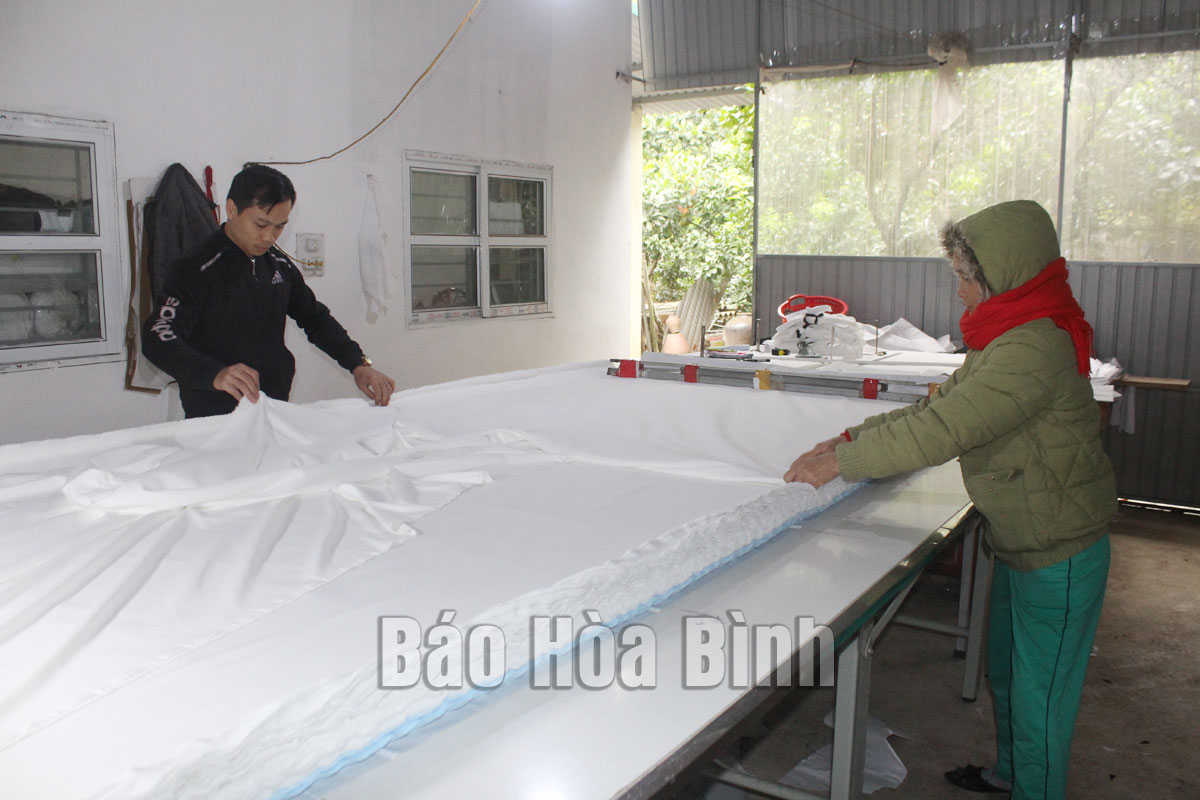
(HBO) – Hoa Binh is striving to bring its economic growth rate to the national average in 2025, which is part of the targets of Resolution 09-NQ/TU issued by the provincial Party Committee’s Standing Board on December 31, 2021, on economic restructuring in association with the transforming of growth model.
Photo: Hoa Binh expects 54 percent of the
industry-construction sector’s proportion in the provincial economic structure.
In the photo: Production at An Phuc garment and textile company in Yen Thuy.
Under the resolution, Hoa Binh aims to reform its economic structure in both
depth and width, enhancing the efficiency of investment, promoting strong
industries and products, and associating fast growth with social progress and
environmental protection, as well as climate change towards sustainable
development.
Specifically, in the 2021-2025 period, Hoa Binh strives to achieve gross
regional domestic product (GRDP) growth of at least 9 percent each year, and
productivity increase of 8 percent per year. In the period, the rate of poor
households is hoped to reduce 2.5-3 percent per year.
The economic structure is expected to continue to be transformed towards a
higher proportion of industry and service and lower rate of the
agro-forestry-fisheries sector. By the end of 2025, per capita GRDP of Hoa Binh
is hoped to reach about 100 million VND (4,408 USD) per year.
Total social investment in the 2021-2025 period is to top 120 trillion VND,
equivalent to about 32 percent of its GRDP, with an average annual rise of 8.2
percent. In the five years, Hoa Binh expects 280 domestically-invested projects
worth about 80 billion VND and 30 foreign-invested projects with a combined
capital of about 1 billion USD.
In 2025, the rate of trained labourers is expected to reach about 63 percent,
while digital economy is hoped to make up about 20 percent to the GRDP.
To this end, the resolution gave eight major solutions, including promoting
communications to create higher social consensus, speeding up provincial
planning, administrative reform and digital transformation as well as business
environment improvement to attract more investment, improving human resources quality,
and enhancing the value of forest production./.
According to data from the Hoa Binh Provincial Party Committee, the industrial production index for the first six months of 2025 is estimated to have increased by 20% compared to the same period last year. This marks the highest year-on-year growth rate for this period since 2020.
In the first six months of 2025, Hoa Binh province’s export turnover was estimated at 1.145 billion USD, marking an 18.11% increase compared to the same period in 2024. Import turnover was estimated at $ 804 million, a 17.15% increase, which helped the province maintain a positive trade balance.
The lives of the ethnic minority farmers in Tan Lac district have gradually improved thanks to the new directions in agricultural production. This is a testament to the collective strength fostered through the professional associations and groups implemented by various levels of the district’s Farmers’ Union.
With the motto the "product quality comes first,” after nearly one year of establishment and operation, Muong village’s Clean Food Agricultural and Commercial Cooperative, located in Cau Hamlet, Hung Son Commune (Kim Boi district), has launched reputable, high-quality agricultural products to the market that are well-received by consumers. The products such as Muong village’s pork sausage, salt-cured chicken, and salt-cured pork hocks have gradually carved out a place in the market and they are on the path to obtaining the OCOP certification.
In the past, the phrase "bumper harvest, rock-bottom prices" was a familiar refrain for Vietnamese farmers engaged in fragmented, small-scale agriculture. But today, a new spirit is emerging across rural areas of Hoa Binh province - one of collaboration, organisation, and collective economic models that provide a stable foundation for production.
Maintaining growing area codes and packing facility codes in accordance with regulations is a mandatory requirement for agricultural products to be eligible for export. Recently, the Department of Agriculture and Environment of Hoa Binh province has intensified technical supervision of designated farming areas and packing facilities to safeguard the "green passport" that enables its products to access international markets.



